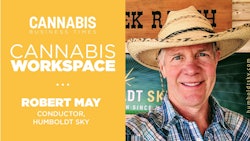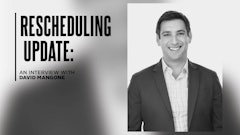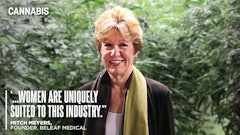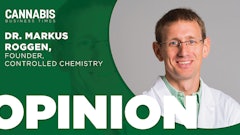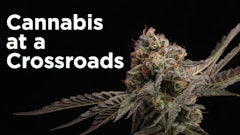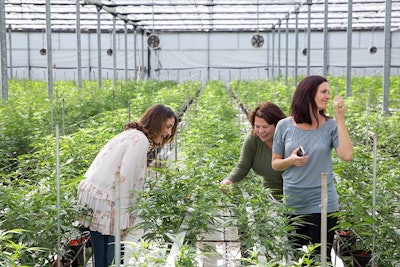
Three Carpinteria women have launched an information and health resource for all things cannabis.
Leigh-Anne Anderson, Tina Fanucchi-Frontado and Amy Marie Orozco describe KopSun as a personal consultant for the cannabis lifestyle. The venture will provide in-depth information on cannabis and its health benefits, as well as a portal for purchasing curated inventory in the oceanside city 80 miles northwest of Los Angeles.
Fanucchi-Frontado’s journey to co-founding the company started a little over two years ago, when her father suffered a massive heart attack. He was prescribed what Fanucchi-Frontado describes as “a plethora of pharmaceuticals,” and Fanucchi-Frontado began dosing him with very small amounts of cannabis edibles to improve his quality of life.
“It definitely didn’t save his life, but it made the end of his life so much better because I could take him off of the pharmaceuticals and he wasn’t having all of the ramifications that the pharmaceuticals leave in your body,” she says.
Here, Fanucchi-Frontado describes her connection to the Carpinteria cannabis industry, the founding of KopSun and its work to provide cannabis education.
Cannabis Business Times: Can you provide some background on KopSun and its journey to launching in California?
Tina Fanucchi-Frontado: We live in Carpinteria. We actually have more growers now per capita in our city than any other place in California. The growers in Carpinteria used to grow flowers, so they’ve been in Carpinteria for 40 years and they’ve been good players. They’ve really helped to build this community, and then they switched over to cannabis a couple years ago.
So, fast-forward, here I am, taking care of my dad. I’m driving between Carpinteria and Santa Barbara because that’s where my husband and I were living and that’s where my career was, and his. I had not really been aware of what was going on in Carpinteria, and then I came out of the fog and learned that the Carpinteria locals were just up in arms over cannabis being grown for basically the smell and all the other fear-mongering that comes into it.
I began to learn about the industry. The Carpinteria industry actually reached out to me and asked if I would help them put together a philanthropic program for them and help to position them. I started touring nurseries and meeting with them and I became so enthralled and enamored with this new industry, particularly in Carpinteria with the best practices that they’re setting, their commitment to our community, their commitment to society, their closed-loop irrigation—just a whole gamut of things. I began to champion the industry to our local government and to our community.
From there, so many people were asking me questions, wanting to know anything from the type of strains to the proper dosing to what is clean cannabis? How do you know that your cannabis is clean? How do you know you’re getting clean cannabis? And that was how KopSun was born. The three of us got together and said, “Let’s create this information and educational resource that people can go to and begin to educate themselves.” On the other side, we go out and we do the due diligence. We tour these sites, we meet with the growers, we know what’s being grown, and then with seed-to-sale [tracking], we can track exactly which dispensaries this is going into and then we can lead those that are following us to purchase these products.
CBT: Can you describe the company’s portal for purchasing curated inventory? How does it work?
TF: That process is still in its infancy and growing. Currently, in Santa Barbara County, there are only two dispensaries—in the entire county. They’re medical. So, there’s no place within our county to purchase adult-use. So, what we do is we drive people to dispensaries, where they can purchase locally cultivated product. Until adult-use opens up [in Santa Barbara County], that’s the only way for them to get it locally. We are positioning KopSun to be the first delivery service for customers throughout Montecito . So, when that happens, we’ll be able to do doorstep delivery, but right now, Carpinteria does not even have a license available. We’re working with the city. We’re in second draft form on an ordinance.
The strains, the types [of cannabis grown in Carpinteria and] the innovative ways that they’re growing are like no other cultivators are able to do outside of our county. We have this opportunity to really be the top shelf for the industry in California, but it takes education. What’s happening is the cultivators are so busy growing and using all of their resources to make the best product possible that they don’t have the bandwidth that it takes to educate and inform possible consumers. And that’s where we stepped in.
Our main followers are women [ages] 35-70. The majority of medication or anything that’s in a women’s bathroom comes from her. She’s the one who buys the medication for the family. She’s the one who dispenses the medication to the family, and unless she’s completely confident in that source, she doesn’t dispense. So, we’re finding that women are our big following group. They’re wanting to learn everything about microdosing and topicals and tinctures and how to dose their animals.
CBT: How will KopSun line up brands and retailers for this?
TF: Like all industry partners, I’m asking them to grow me a lower-THC strain because I’m finding that there are many women who, like myself, would like to indulge, but we don’t want to be super high with a 20-percent THC product. We want a lower percentage of THC.
Microdosing is huge for our demographic, and we need to have it in a variety of dosing options, from mints to tinctures to other forms of edibles.
There is also a THC-V, which is a weight loss strain, so it doesn’t give you the munchies.
The other thing is the names of the products. We’re just right now in that think-tank stage because we’re creating our own strains of names that are appealing to our demographic. We don’t want anything that sounds like we’re going to gain weight from it. So, we don’t want anything that sounds like “chocolate cake.” And we don’t want anything that sounds like the “devil’s rush.” We want something that sounds appealing and inviting.
CBT: What does the company look for in its mission of focusing on local cannabis?
TF: Are they socially responsible? And we’re not just talking about a best practice, and we’re not just talking about environmentally responsible. Especially in Santa Barbara County, we were hit drastically by fires, and then we had a horrible debris flow that killed 23 people in Montecito . Our community has just been annihilated. We just lost a young man to the shooting in Thousand Oaks. So, environment is really important for us. We want to make sure that you’re being smart with how you use your water. We want to make sure that you’re being smart with how much electricity you use for lighting, [and] that you’re being smart with the transportation. But we also need you to be good players in our community. How do you philanthropically support this community that you’re doing business with?
So, we personally vet out the growers locally. We personal tour the nursery and meet with them. This is more than being on the phone and talking with someone who has a line [and] who is trying to get it on our shelf. We want to know our source, so that we can give our followers and our future customers the confidence that they need to make really smart decisions.
CBT: How can cannabis businesses play a role in advancing a new, wellness-based perception of cannabis, and why is this important?
TF: We do presentations around the community. We have one next week with Hospice of Santa Barbara and then one after that with visiting nurse and hospice care. We meet with doctors. We work with everybody within the [health care] industry to educate them about the health and relief benefits of cannabis. It takes a lot of face-to-face, and our presentations—although they’re only 30 minutes—the Q&A always lasts another hour. Those questions that we can’t answer, we jot down, come back, research and then reach back out to those who are participating.
So, again, it’s really a lot of reaching out to those in the health industry. It’s really boots on the ground. It takes a tremendous amount of time and resources, but we’re battling the misconceptions, we’re battling the fears and we’re providing the information.
This interview has been edited for length and clarity
Top photo courtesy of KopSun











